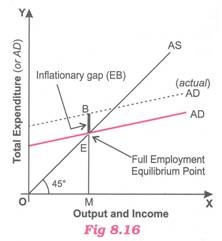Excess Demand: Meaning, Inflationary Gap, Reasons and Impacts (with diagram)!
There can be two situations of aggregate demand, namely excess demand and deficient demand. Let us first understand excess demand.
Meaning:
When in an economy, aggregate demand is in excess of ‘aggregate supply at full employment’, the demand is called an excess demand.
ADVERTISEMENTS:
Alternatively when aggregate demand exceeds ‘aggregate supply at full employment level the demand is said to be an excess demand and the gap is called inflationary gap. The gap is called inflationary because it causes inflation (continuous rise in prices) in the economy.
Inflationary Gap:
When aggregate demand is more than ‘level of output at full employment’, then the excess or gap is called inflationary gap. Alternatively ‘it is the amount by which actual aggregate demand exceeds the level of aggregate demand required to establish the full employment equilibrium.’ Thus, inflationary gap is a measure of the amount of excess of aggregate demand over ‘aggregate supply at full employment’.
In such a situation, an increase in demand means only an increase in money expenditure without any corresponding increases in output and employment because all the resources have already been fully employed. A simple example will further clarify it.
Let us suppose that an imaginary economy by employing all its available resources can produce 10,000 qtls of rice. If aggregate demand for rice is, say, 12,000 qtls., this demand will be called an excess demand because aggregate supply at the level of full employment of resources is only 10,000 qtls. As a result, the excess of 2,000 qtls will be called an inflationary gap.
ADVERTISEMENTS:
This situation is depicted in Fig. 8.16. Here, point E lying on 45° line is the full employment equilibrium point. This is an ideal situation because aggregate demand represented by EM is equal to full employment level of output (aggregate supply) represented by OM.
Suppose, the actual aggregate demand is for a level of output BM which is greater than full employment level of output EM (OM). The difference between the two is EB (BM – EM) which is a measure of inflationary gap or excess demand.
In short, the inflationary gap is the amount by which the actual aggregate demand exceeds the aggregate demand required to establish full Output and Income employment equilibrium.
Reasons:
ADVERTISEMENTS:
The main reasons for excess demand are apparently the increase in four components of aggregate demand (see Section 8.4). For instance, there may be (i) increase in household consumption demand due to rise in propensity to consume; (ii) increase in private investment demand because of rise in credit facilities; (iii) increase in public (government) expenditure; (iv) increase in export demand and (v) increase in money supply (deficit financing) or increase in disposable income (due to fall in rate of taxes).
Impact of Excess Demand:
Briefly, it causes rise in prices and increases in equalities:
Generally, excess demand results in inflation (continuous rise in prices) without increase in output and employment. But in different situations in the economy, the impact will also be different. We discuss the impact of excess demand in reference to these situations, namely, (i) Whether, the economy is in a state of unemployment or full employment, (ii) Whether the supply of factors of production is elastic or inelastic.
Thus, following will be the impact of excess demand on prices, employment and output:
(i) If it is a state of voluntary unemployment and unemployed factors become ready to work, a rise in demand will lead to an increase in output and employment, i.e., voluntary unemployment will be lessened. Increase in demand helps the output and employment to increase without an increase in prices so long as there are unemployed and under-employed resources.
(ii) If it is a state of full employment, i.e., involuntary unemployment does not exist, excess demand results in inflation or general rise in price level. Employment will not increase because there is no involuntary unemployment.
Output will also not increase since all the available resources are already being used fully. Of course, there can be a possibility of increase in output only if productivity of labour is increased in the long period. But in short period, when it is not possible to increase productivity of labour, an inflationary situation may develop due to rise in prices.
(iii) As far as impact on prices is concerned, if supply of other complementary factors is elastic, prices will not be affected much due to matching adjustment in output and emplo3mient. But if supply of factors is inelastic, prices will rise since output cannot be increased appreciably.
We may conclude that increase in demand beyond the level of full employment does not lead to an Increase in output and employment. Without increase in total output (supply), excess demand ultimately consumes itself into price rise, i.e., degenerates into inflation with adverse effects on saving, production and distribution.
ADVERTISEMENTS:
It is because of this phenomenon that sometimes it is said that increase in aggregate demand beyond the level of full employment leads to an increase not in real income (in terms of goods and services) but in money income.
Causes of Excess Demand:
These are:
(i) Deficit financing (printing of currency notes), (ii) Increase in Marginal Propensity to consume and (iii) Increase in autonomous investment.
